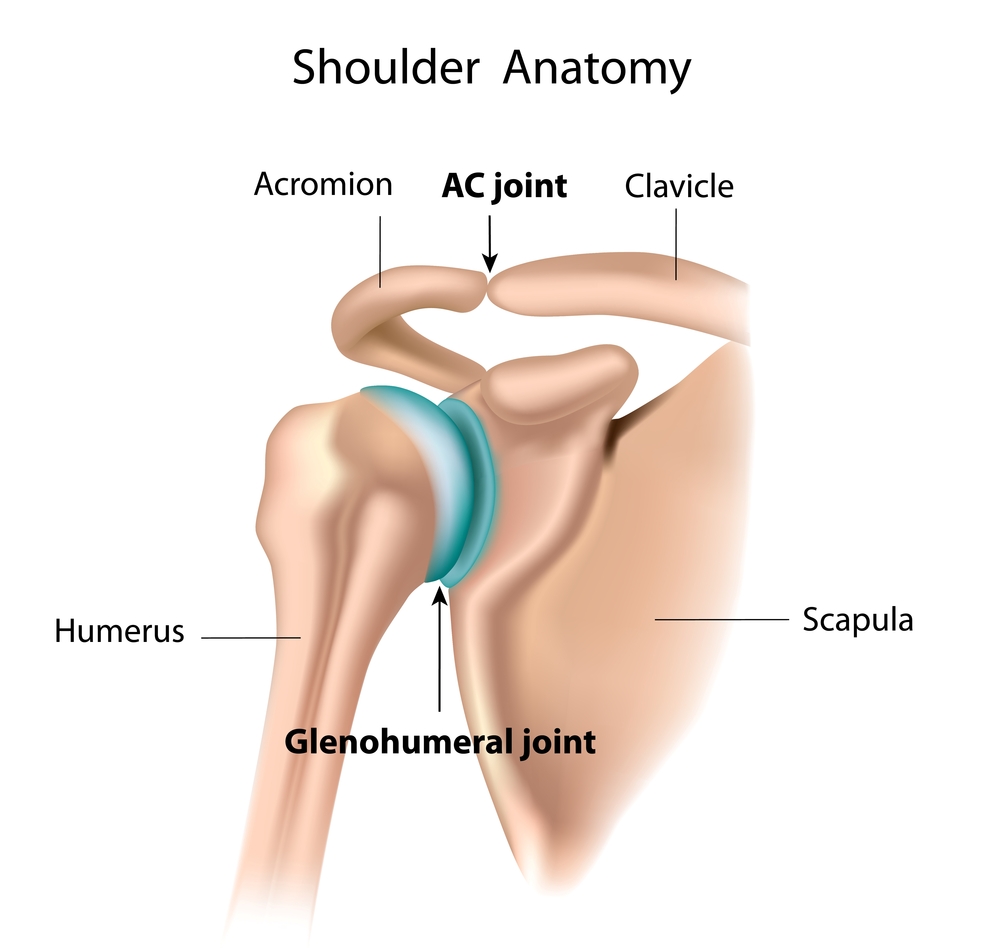Every that can go wrong in your shoulder
The shoulder is one of the most complicated joints of the human body. It is constructed in such a way that it can be moved in all directions. As a result, you are able to perform the most complex movements, like combing your hair, lifting a box, drinking a cup of coffee, or brushing your teeth. Because of this flexibility and complex construction, a lot of things can go wrong in the shoulder. As a result ‘Moving without pain’ addresses the most important issues in this article for you.
- How is the shoulder constructed?
- Osteoarthritis in the shoulder
- Frozen shoulder
- RSI in the shoulder
- Mucous membrane inflammation in the shoulders
- Tendon inflammation in the shoulder
- Tendon calcification in the shoulder
- Shoulder Belt Syndrome
How is the shoulder constructed?
The shoulder is made up of three bones: the clavicle, the shoulder blade and the upper arm. It is equipped with two joints that work closely with each other in order for the arm to be able to move to all sides. The glenohumeral joint (between the shoulder blade and upper arm) has the shape and function of a ball joint. The relatively large ball on the upper arm rolls and turns into the shoulder socket. This joint makes it possible for the arms to rotate and move to and from your body. Both the ball and the socket have a layer of cartilage in order for the bones to be able to slide smoothly over each other.
Above it is the Acromio Clavicular joint or AC joint. This is a sliding joint that is located between the clavicle and the shoulder tip. This joint allows you to lift your arms over the head. Around the shoulder joints there is a variety of ligaments and muscles. Furthermore, these are needed for the shoulder stability and for controlling and guiding movements.
Osteoarthritis in the shoulder
This disease can occur in both the glenohumeral and acromioclavicular joint. Usually the cartilage becomes worn in the joints due to aging. As a consequence, the shoulder joints come closer to each other. Finally, this wearing process can also be triggered by prolonged shoulder inflammations, accident, or overload.
Read more about shoulder osteoarthritis.
Symptoms of osteoarthritis in the shoulder
Shoulders might hurt the most during movement. After a long period of rest – for example sleeping – there may be pain and stiffness. These symptoms usually go away. In the case of advanced osteoarthritis, bone-to-bone contact may occur, which can be very painful.
Diagnosis and treatment of osteoarthritis in the shoulder
First, the doctor will rule out whether the pain and stiffness are caused by another condition. If this is not the case, a CT scan will be done to determine the extent of cartilage loss. In light forms of osteoarthritis, a physical therapist can help. He can guide you through exercises to put different strain on the shoulders. In case of pain, the doctor may prescribe inflammatory inhibitors. These NSAIDs, however, cause frequent adverse side effects. A good alternative is liquid Green-lipped mussel with Bio-Curcumin and Blackcurrant leaf. These natural pain killers and inflammatory inhibitors provide 70 percent of the users with a satisfactory result.
In an advanced stage of shoulder osteoarthritis, the shoulder joint might optionally be replaced by a shoulder prosthesis.
Frozen shoulder
This is an inflammation of the shoulder joint, causing the capsule to shrink and thicken. The shoulder becomes stiff and cannot make any movements anymore. This can make it difficult to perform everyday operations. If the complaints occur spontaneously and without a clear cause, it is called primary frozen shoulder. If the complaints occur after an accident or surgery, it is called a secondary frozen shoulder.
Symptoms of frozen shoulder
In the first phase there is continuous pain in the shoulders due to inflammation. At the next stage, the shoulder feels stiff and the mobility options are limited. In the recovery phase, pain and stiffness decrease and the shoulder can be moved more easily.
Diagnosis and treatment of a frozen shoulder
With a frozen shoulder the doctor will be able to notice a clear limitation of movement of your shoulder. To exclude other conditions, an X-ray of your shoulder will be made. A frozen shoulder heals anywhere within a period of 10 months to 3 years. Physical therapy can help speed up recovery. Pain control usually occurs with anti-inflammatory drugs or a temporary nerve block. Liquid Green-lipped mussel with Bio-Curcumin does not affect the pain, but may reduce the stiffness of the shoulder joint.
RSI in the shoulder
Repetitive Strain Injury (RSI) occurs in the shoulders by repeatedly making small movements. Because the muscles of the shoulders and arms continuously contract, they become overloaded. Blood flow decreases and the muscles involved start to hurt. In the end, painful inflammation may occur or nerves may get stuck.
Read more about RSI
Symptoms of RSI in the shoulder
RSI starts with pain and fatigue in the muscles and joints used to perform the repetitive movements. After a period of rest, these symptoms disappear naturally. At the next stage, the symptoms will continue after a rest period. RSI is diagnosed when the pain is present in the shoulder joint during the day and night and the shoulder can hardly be used.
Diagnosis and treatment of RSI in the shoulder
There is no specific test to diagnose RSI. The doctor will have to eliminate all other possible shoulder complications. There is also no specific treatment for RSI. The doctor will advise you to keep your shoulder moving, but then in a controlled way. A physical therapist can help to reduce your symptoms. A company doctor can provide ergonomic advice to improve working conditions.
Paracetamol or an anti-inflammatory drug may help reduce the pain.
Bursitis in the shoulders
Mucus fairs are pads filled with slimy fluid. They ensure that the joints move smoothly, without the tendon rubbing over the joint. The mucus in the shoulder is most prone to inflammation. Usually this condition is caused by excess strain, for example after painting all day.
Read more about Bursitis.
Symptoms of a Bursitis in the shoulder
There are clear signs indicative of an inflammation. The mucus, in the shoulder, becomes swollen and hurts. Also, the place can be red and hot. The tendon has less space to move because of the swelling. When you do move, this can be accompanied by short periods of severe pain.
Diagnosis and treatment of mucous membrane inflammation in the shoulder
As with many other conditions of the shoulder, the doctor will have to exclude certain conditions. It will be examined whether there is a local inflammation in the shoulder or a phenomenon of a rheumatic disease. Sometimes an X-ray can be used to have a closer look at the shoulder joint condition. In case of a mucous membrane inflammation, the doctor will advise you to give the shoulder as much rest as possible. Usually, the condition goes away by itself.
Paracetamol can be taken to help manage the pain. Sometimes the doctor finds it necessary to prescribe NSAIDs.
Tendon inflammation in the shoulder
A tendon inflammation or tendinitis is most common in the shoulder. As with RSI and frozen shoulder, overload is the cause of this condition. Tendons connect muscles with bones. These fibrous structures are not very stretchable. A small tear is already enough to trigger an inflammatory reaction. Often the sheath covering the tendon is also affected.
Read more about a tendon inflammation in the shoulder.
Symptoms of a tendon inflammation in the shoulder
The tendon inflammation causes pain in the shoulder. In addition, the place can be swollen and feel warm. The shoulder is rigid and is difficult to move. Sometimes, when moving the inflamed tendon, a soft creak of crispy sound is heard. This is called crepitus.
Diagnosis and treatment of tendon inflammation in the shoulder
The physician will make his diagnose on the basis of symptoms and physical examination. It will be advised to relieve the inflamed tendon as much as possible. In addition, analgesic and anti-inflammatory drugs – NSAIDs – can be prescribed. Liquid Green-lipped mussel with Bio-Curcumin and Blackcurrant leaf is not effective in a tendonitis.
Tendon calcification in the shoulder
This condition is mainly found in the tendons of the shoulder and in the shoulder capsule. In this condition, calcium is deposited in the tendons. This may cause a painful feeling. Scarring is probably due to decreased blood flow through the shoulder area. This causes the tendon cells to make calcium.
Read more about tendon calcification in the shoulder.
Symptoms of tendon calcification in the shoulders
Calcification does not always have to be accompanied by physical symptoms. The tendon may be compressed by the surrounding sheath, as a result of the calcification becoming larger. Consequently lifting, or lying on the shoulder can cause pain, and the shoulder will not move as well.
Diagnosis and treatment of tendon calcification in the shoulder
An X-ray can indicate whether there is a tendon calcification clearly showing the calcium spots. There are several treatment options for a tendon calcification. Waiting is the first option; calcium spots are spontaneously dissolved most of the time. An injection with corticosteroid inflammatory inhibitors has an analgesic effect. Injecting with a needle can cause the calcium to dissolve. This is called Barbotage or Needling. Treatment with shock waves (Extracorporal ShockWave Therapy or ESWT) seems like very effective against pain. Finally, an endoscopic procedure can remove the calcium deposit.
Shoulder Belt Syndrome
This condition is also known as Thoracic Outlet Syndrome or TOS. This is a tightening of the vascular nerve bundle that goes from the neck and chest cavity to the arms. Usually, it affects a nerve (NTOS) that has been compromised. As a result, they can no longer correctly transmit signals. In addition a blood vessel (VTOS) or even ankle artery (ATOS) may get stuck. The blood circulation in the arm and hand is then disturbed.
Read more about the shoulder belt syndrome.
Symptoms of the shoulder belt syndrome
Most notably, a compressed nerve in the shoulder region causes a nauseous, dull and burning pain. Also the arm and even the fingers can tinkle. Power loss may occur, which makes you drop thing easily. When the problem occurs with a blood vessel, the arm may become blue and thick. In a truncated artery, the arm becomes cold and pale as a result of the disturbed blood circulation.
Diagnosis and treatment shoulder belt syndrome
It is important that you carefully describe the symptoms to the GP. Most GPs do not recognize a shoulder belt syndrome immediately. Symptoms in the shoulder and neck area are provoked by a number of tests. A radiographic examination, an MRI scan or a nerve conduction examination can confirm the diagnosis. Usually, a physical therapist will treat the complaints. He will try to eliminate the nerve string compression through exercises. Surgery may be required.

Share this page
Tweet

Download for free the booklet ‘Moving without pain’ with a retail value of $6.75 / £4.95.
Any questions? Please feel free to contact us. Contact us.







